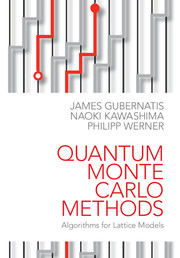Book contents
- Frontmatter
- Contents
- Preface
- Part I Monte Carlo basics
- Part II Finite temperature
- 6 Finite-temperature quantum spin algorithms
- 7 Determinant method
- 8 Continuous-time impurity solvers
- Part III Zero temperature
- Part IV Other topics
- Appendix A Alias method
- Appendix B Rejection method
- Appendix C Extended-ensemble methods
- Appendix D Loop/cluster algorithms: SU(N) model
- Appendix E Long-range interactions
- Appendix F Thouless's theorem
- Appendix G Hubbard-Stratonovich transformations
- Appendix H Multi-electron propagator
- Appendix I Zero temperature determinant method
- Appendix J Anderson impurity model: chain representation
- Appendix K Anderson impurity model: action formulation
- Appendix L Continuous-time auxiliary-field algorithm
- Appendix M Continuous-time determinant algorithm
- Appendix N Correlated sampling
- Appendix O The Bryan algorithm
- References
- Index
7 - Determinant method
from Part II - Finite temperature
Published online by Cambridge University Press: 05 May 2016
- Frontmatter
- Contents
- Preface
- Part I Monte Carlo basics
- Part II Finite temperature
- 6 Finite-temperature quantum spin algorithms
- 7 Determinant method
- 8 Continuous-time impurity solvers
- Part III Zero temperature
- Part IV Other topics
- Appendix A Alias method
- Appendix B Rejection method
- Appendix C Extended-ensemble methods
- Appendix D Loop/cluster algorithms: SU(N) model
- Appendix E Long-range interactions
- Appendix F Thouless's theorem
- Appendix G Hubbard-Stratonovich transformations
- Appendix H Multi-electron propagator
- Appendix I Zero temperature determinant method
- Appendix J Anderson impurity model: chain representation
- Appendix K Anderson impurity model: action formulation
- Appendix L Continuous-time auxiliary-field algorithm
- Appendix M Continuous-time determinant algorithm
- Appendix N Correlated sampling
- Appendix O The Bryan algorithm
- References
- Index
Summary
This chapter introduces a finite-temperature algorithm for the simulation of interacting electrons on a lattice. Because this algorithm was developed by Blankenbecler, Scalapino, and Sugar (1981; Scalapino and Sugar, 1981), it is sometimes called the BSS algorithm. The method uses a Hubbard-Stratonovich transformation to convert the interacting electron problem into a noninteracting one coupled to an imaginarytime- dependent auxiliary field. For this reason, it is also called the auxiliary-field method. We use here yet another name, the determinant method, which is fitting because the transformation to a problem of noninteracting electrons generates determinants as the statistical weights. The finite-temperature determinant algorithm is a general-purpose electron algorithm that enables computations of a wide variety of local observables and correlation functions. For a discussion of a zero-temperature determinant method, refer to Appendix I.
Theoretical framework
Feynman and Hibbs (1965) formulated quantum mechanics in terms of integrals over all paths in configuration space. In real time, each path contributes a phase to the integral that is determined by the classical action along the path. Two paths can interfere constructively or destructively. In the classical limit, only the stationary-phase path is important. Being characterized by many interfering paths, real-time quantum dynamics more than challenges importance sampling. Statistical mechanics, on the other hand, involves path integrals in imaginary time. Contributions to the integrals vary exponentially in magnitude but not in phase. Thus, the path integral is dominated by paths of large magnitude. The tasks of a quantum Monte Carlo method are identifying these important paths and sampling them efficiently.
In this chapter, we address the classicization of many-electron problems at finite temperatures via a Feynman path integral. The result is a method often called the determinant method as the weights of the paths can be expressed as determinants, hardly classical-looking weights, but ones quite suggestive of the antisymmetry of Fermion states. Sampling these weights efficiently and in a stable manner requires special techniques. We begin with a brief overview to motivate the general form of the classical representation and the weights we need to sample.
- Type
- Chapter
- Information
- Quantum Monte Carlo MethodsAlgorithms for Lattice Models, pp. 180 - 213Publisher: Cambridge University PressPrint publication year: 2016

